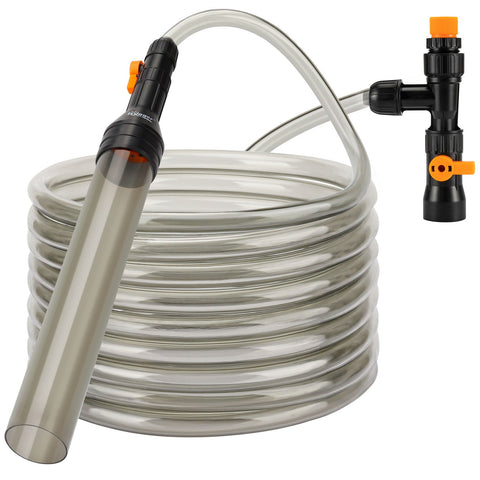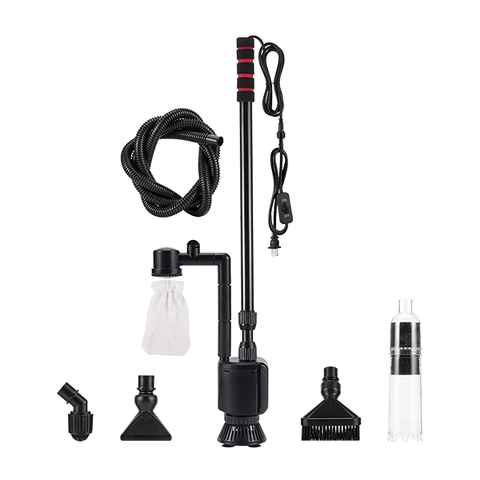Cleaning a fish tank is time-consuming but worthwhile. There is much waste accumulated in your aquarium that will influence the health of your fish, the ornament of your aquarium and the environment of the room where you put your aquarium.
It is vital for you to clean your fish tank regularly, but how to do it? What should you prepare and how often should you do a thorough cleaning? Keep reading, this article will give a specific guide on how to clean your fish tank.
What should we remove by cleaning a fish tank?
First, let’s start with the waste that results in a dirty fish tank. I’ll divide it into visible waste and invisible waste.Visible waste
Visible waste includes the dead bodies of the creatures, such as dead fish, shrimps, snails and plants. It also includes the uneaten food that you feed to your lovely pets and excessive algae.
Invisible waste
Waste that is invisible means it can be dissolved in water, so you can not see it. This kind of waste includes nitrates, ammonia, tannins, hydrogen sulfite, chlorine, chloramine and so on. They are more fatal to fish since we can not notice their presence.
Tools needed for fish tank cleaning
- A bucket
- A piece of cloth
- Your clean hands
- Water test kit
- Water conditioner
- Gravel cleaner
- Algae cleaner
- Water changer
- Thermometer
Follow the above list to prepare cleaning tools, if you lack some of them, you can go to petnannystore.com and buy some. There are many high-quality aquarium products for you.
How to clean a fish tank? (Step by step)
Step 1 Get all your tools sterilized
Although the tools you prepared are newly bought, you need to sterilize them to make sure they won’t bring any bacteria to the fish tank.
Step 2 Unplug the electronic equipment
The aquarium heater, aquarium light, aquarium filter, water pumps, air pumps and other equipment in your fish tank are electronic, which will break or hurt you in some circumstances, so you need to make sure you have unplugged all of them before you clean the fish tank.
Step 3 Dechlorinate tap water
You can not just pour tap water into your fish tank before you dechlorinate it, or the high chlorinate level in your fish tank will stress your fish and harm them. If you are going to change the water while cleaning the fish tank, I’ll suggest you prepare a bucket of tap water and add some water conditioner to it, then leave it for about 24 hours before you pour it into your fish tank. You can clean other stuff in your aquarium during the 24 hours, so when you have cleaned the fish tank, the water can be ready for you.
Step 4 Clean the outside of the fish tank
Cleaning the outside of the fish tank is the easiest step, you just need to use a piece of cloth, a sponge or anything soft to wipe the glass. If you can still not see your lovely pets clearly, you need to take the next step--clean the inner glass.
Step 5 Use a cleaner to clean the inner glass
The cleaning of the inner glass of the fish tank will help you see your pets and decorations. You can use AQQA Magnetic Aquarium Cleaner Brush or Hygger Aquarium Strong Magnetic Cleaner to clean the inner glass. These cleaners are very helpful for removing algae and other dirt on the glass, you can make it clean within a short time.
Step 6 Clean the substrate in your fish tank
The waste will fall to the substrate and accumulate in it, so if you ignore the maintenance of the substrate, you are bringing a potential threat to your fish.
Cleaning the substrate is not difficult, you can use a gravel cleaner that can siphon the dirt in the substrate to achieve your goal. But you need to pay attention to the fish when you are siphoning since the tiny fish will be sucked up by the siphon.
Step 7 Use a net to collect the visible waste floating in the water
Once you have cleaned the inner glass and the substrate of the fish tank, you will find much waste floating in the water. Now you can use a net to collect most of them and throw them into the garbage.
Step 8 Clean the decorations in your fish tank
Actually, a substrate is one of the decorations in a fish tank, but the cleaning of it is different from the cleaning of other decorations, so I divide the decorations cleaning into two parts. This is the second part.
Decorations in a fish tank include plants (both real and artificial), rocks, caves, and driftwood. You can clean of all them by rinsing them, but you should use treated water to rinse, or they will bring chlorinate into the fish tank. For rocks, caves and driftwood, you can also boil them to make them clean.
Step 9 Clean the equipment in your fish tank
Many people ignore this step since they think it’s not necessary, however, they are wrong. Cleaning the equipment is a way of prolonging its service life and making them work better. The equipment that is submerged in the water will have waste accumulated, which will influence its operation.
And the equipment outside the fish tank will have dust, which may block the radiator. Most of the equipment is waterproof, you can clean them in the same way as cleaning the decorations, just rising them with treated water.
Step 10 Clean the filter
A filter is an equipment in the fish tank, but I separate it from others since you can not clean the filter when you are cleaning the fish tank. An old fish tank has many beneficial bacteria in it, and so does a filter.
If you clean the filter and the fish tank at the same time, you will remove a great number of beneficial bacteria, which will destroy the biological system in your aquarium and get your fish stressed. The proper interval between cleaning the fish tank and the filter is 2 weeks.
You can clean the filter by rinsing the filter media or replacing them. But do remember just replacing parts of them since the beneficial bacteria prefer to stay in the media.
Step 11 Change the water
The above steps can help you remove most of the visible waste and some of the invisible waste in your fish tank. You will find your fish tank clearer than before, but it doesn’t mean you have finished the cleaning. You also need to remove the toxins in your fish tank. Although they will be filtered by your filter, you still need to do water changes regularly.
It is not necessary for you to change the water once you clean the fish tank, and it is not recommended to change all of the water at one time. You can do it on a regular basis and change no more than 50% of the water each time.
Preparing a water changer will make this step easier, you can choose:
- Hygger Automatic Aquarium Gravel Cleaner and Water Changer
- AQQA Electric Aquarium Gravel Cleaner and Water Changer
Both of them can serve as a gravel cleaner and a water changer, so you can use one tool to finish two cleaning steps.
Step 12 Test the water and pour it into the fish tank
Once you have finished the cleaning steps, you can now have a rest and wait until the 24 hours are over. Then, you need to use a water test kit to test the water parameters, such as pH level, hardness and water temperature. Make sure the water conditions are suitable for fish to live.
How often to clean a fish tank?
It depends on the fish you are keeping, the number of fish, the size of your tank and the efficiency of your filtration system. Cleaning the fish tank is not daily work, you can do it every one or two weeks or one month.
Water change can be done per week if you change 10%-15% of the water every time. If you change more than 20% of water, you can do it every two weeks. Also, the interval should be determined by the fish you are keeping, the number of fish in your aquarium and so on.





Comments (0)
Back to Aquarium Maintenance